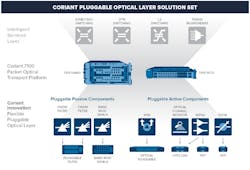Coriant's Pluggable Optical Layer architecture disaggregates optical functions
Optical transport systems company Coriant has unveiled its Pluggable Optical Layer concept, which disaggregates various optical layer functions into pluggable modules that operators can mix and match according to their requirements. Supported initially in the company's 7100 metro packet-optical transport systems, Coriant likely will apply the concept to other platforms as well, said company sources.
As illustrated above, the combination of Pluggable Optical Layer modules and the various members of the 7100 family offer flexibility in both chassis size and optical layer capabilities. The packet processing and switching capabilities of the various 7100 platforms remain untouched, according to Brian Nagle, director of product line management, and Bill Kautz, director of strategic solutions at Coriant. However, the Pluggable Optical Layer concept enables operators to choose the optical layer functions required at each location, which the option of adding capabilities as those requirements change.
The result is low initial cost and a pay-as-you-grow capability expansion, they said.
The modules include a range of passives, such as DWDM and CWDM filters and band mux/demux units, which would plug into a separate 1RU shelf. The active modules, in most instances, would plug into a new carrier card for the 7100s. The modules come in a variety of sizes, including some as small as XFP and SFP optical transceivers. They include a wavelength-selective switch (WSS), optical channel monitor, EDFAs, and electronic variable optical attenuators (EVOAs). The smaller XFP- and SFP-style modules may not require the carrier card in some configurations, Kautz noted; they could plug into ports on already fielded line cards.
The company expects to make most of the passives and the active amplification modules available by the end of the year, with the other modules following in 2016. Kautz explained that the current availability of Coriant's ROADM-on-a-blade made the other modules a higher priority.
Nagle and Kautz said the company has begun to show the technology to carrier, Internet content provider, and data center operator customers. Customer trials are underway, they added.
For more information on high-speed transmission systems and suppliers, visit the Lightwave Buyer's Guide.

Stephen Hardy | Editorial Director and Associate Publisher
Stephen Hardy has covered fiber optics for more than 15 years, and communications and technology for more than 30 years. He is responsible for establishing and executing Lightwave's editorial strategy across its digital magazine, website, newsletters, research and other information products. He has won multiple awards for his writing.
Contact Stephen to discuss:
- Contributing editorial material to the Web site or digital magazine
- The direction of a digital magazine issue, staff-written article, or event
- Lightwave editorial attendance at industry events
- Arranging a visit to Lightwave's offices
- Coverage of announcements
- General questions of an editorial nature
